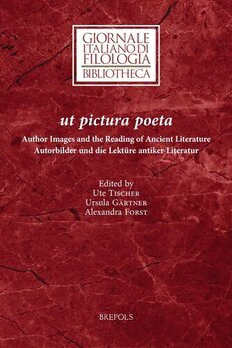
Ut pictura poeta: Author Images and the Reading of Ancient Literature / Autorbilder und die Lekture antiker Literatur (Giornale Italiano Di Filologia - Bibliotheca, 29) (English and German Edition) PDF
380 Pages·2022·2.355 MB·English
Most books are stored in the elastic cloud where traffic is expensive. For this reason, we have a limit on daily download.
Preview Ut pictura poeta: Author Images and the Reading of Ancient Literature / Autorbilder und die Lekture antiker Literatur (Giornale Italiano Di Filologia - Bibliotheca, 29) (English and German Edition)
Description:
The leitmotif of this volume is the concept of 'author images', which is used in modern literary studies to describe processes of production and reading of literary works and is here applied for the first time to the study of ancient works. As a means of analysing ancient literature, it captures the aspect of personification, which is characteristic of ancient author concepts, and at the same time points to the fact that there is a difference between 'image' and 'author' and that it is only an image and not the author himself that can be seen and grasped by readers. This makes the 'author image' particularly suitable for examining the intersections of material, rhetorical and mental representations of literary authorship that form the subject of this volume. Using selected examples from Latin and Greek literature, the contributors explore the fields of cultural experience that nourish authorial images. They discuss the manifold possibilities of visualising and representing a person's quality of being an author in general or being an author of specific works, be it physically through artworks or pictures, metaphorically through evoked authorial figures, through thematised representations of authors in a text, or through the combination of authorial images and texts. These issues are addressed in four overlapping sections, each focusing on different areas of the metaphor's application, namely material images in the form of artworks, knowledge about persons, textual images as authorial strategies and images in reception.
See more
The list of books you might like
Most books are stored in the elastic cloud where traffic is expensive. For this reason, we have a limit on daily download.
